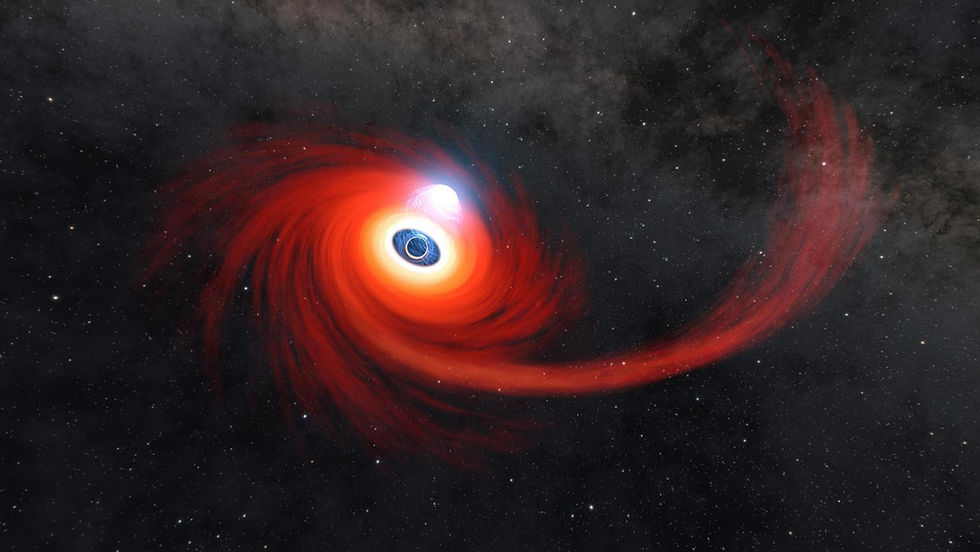Black Holes—Cosmic Monsters Warping Space & Time
- Bruce

- Jun 27
- 4 min read

Black holes are among the most mysterious and fascinating objects in the universe. They possess gravitational pulls so strong that nothing, not even light, can escape their grasp. Understanding the structure and physics of black holes helps us delve deeper into the cosmos's secrets.
What Is a Black Hole?
A black hole is a region in space where gravity is so intense that it warps space and time, preventing anything from escaping its pull. This phenomenon occurs when a massive amount of matter is compressed into a tiny area, leading to a gravitational field so strong that even light cannot escape.
Formation of Black Holes
Black holes typically form from the remnants of massive stars that have ended their life cycles. When such a star exhausts its nuclear fuel, it undergoes a supernova explosion, and if the remaining core is sufficiently massive, it collapses under its own gravity into a black hole.
Anatomy of a Black Hole
To comprehend black holes, it's essential to explore their key components:
Singularity
At the core of a black hole lies the singularity, a point where matter is compressed to infinite density, and the known laws of physics cease to function. This means that all the mass of the black hole is concentrated into an infinitely small space.
Event Horizon
Surrounding the singularity is the event horizon, often referred to as the "point of no return." Once an object crosses this boundary, it cannot escape the black hole's gravitational pull. The event horizon is not a physical surface but a spherical boundary where the escape velocity equals the speed of light.
Accretion Disk
Outside the event horizon, black holes often have accretion disks—hot, swirling rings of gas and dust spiraling into the black hole. As this matter accelerates and heats up, it emits light, making the area around the black hole detectable.
Photon Sphere
Just outside the event horizon lies the photon sphere, a region where gravity is so strong that light can orbit the black hole. However, these orbits are unstable, and any disturbance can cause the light to either fall into the black hole or escape into space.
Relativistic Jets
Some black holes emit powerful jets of particles moving at speeds close to the speed of light. These relativistic jets are believed to be caused by the interaction of the black hole's magnetic fields with the accretion disk, propelling particles away from the black hole's poles.
Types of Black Holes
Black holes come in various sizes, primarily categorized based on their mass:
Stellar Black Holes
These black holes form from the collapse of massive stars and typically have masses up to 20 times that of our Sun.
Intermediate-Mass Black Holes
These are black holes with masses between stellar and supermassive black holes, ranging from hundreds to thousands of solar masses. Their formation process is still a topic of research.
Supermassive Black Holes
Found at the centers of most galaxies, including our Milky Way, supermassive black holes have masses ranging from millions to billions of times that of the Sun. Their origin remains one of the significant mysteries in astrophysics.
The Physics of Black Holes
The extreme conditions around black holes provide a unique environment to study the laws of physics:
Gravitational Time Dilation
Near a black hole, time behaves differently due to intense gravity—a phenomenon predicted by Einstein's theory of general relativity. An observer far from the black hole would perceive time near the event horizon as moving slower.
Spaghettification
The term "spaghettification" describes the process where objects approaching a black hole are stretched and compressed due to extreme tidal forces. This effect results from the difference in gravitational pull experienced by different parts of the object.
Hawking Radiation
Proposed by physicist Stephen Hawking, this theory suggests that black holes can emit radiation due to quantum effects near the event horizon. Over time, this could lead to black holes losing mass and potentially evaporating completely.
Observing Black Holes
While black holes themselves are invisible, their presence can be inferred through their interactions with surrounding matter:
X-ray Emissions
As matter from a companion star falls into a stellar black hole, it heats up and emits X-rays, which can be detected by space telescopes.
Gravitational Waves
The collision and merger of black holes produce ripples in spacetime known as gravitational waves. Detectors like LIGO have observed these waves, providing direct evidence of black hole mergers.
Event Horizon Telescope (EHT)
In 2019, the EHT collaboration released the first image of a black hole's event horizon, providing visual confirmation of these enigmatic objects.
Conclusion
Black holes are among the most mysterious and powerful objects in the universe, pushing the limits of our understanding of physics, space, and time. From their event horizons to their infinitely dense singularities, these cosmic giants warp reality in ways that challenge our best scientific theories. While we cannot directly see black holes, we can observe their effects—through X-rays, gravitational waves, and even direct imaging. As research continues, black holes may unlock deeper insights into the nature of gravity, quantum mechanics, and the very fabric of the universe itself. One thing is certain: the more we learn about black holes, the more questions arise, making them one of the most fascinating frontiers in modern astrophysics.






Comments